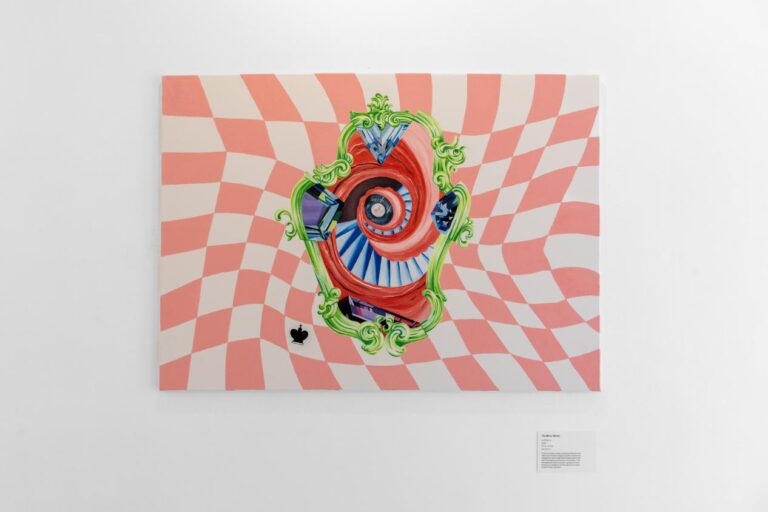Compared to the sweltering, brattily chaotic first day of Primavera Sound 2025, Day 2 went by like a breeze. The performances I saw were a bit more all over the place, with feeble little horse appearing on the same stage as Wolf Alice and Sabrina Carpenter succeeding Beach House – but unified by the idea of simply putting on a good show. (Which, in both Carpenter and Haim’s case, included strong affirmations of the audience’s hotness.) In chronological order, here are six highlights from the second day of Primavera Sound 2025.
A Litte Bit of feeble litte horse, A Bit More Wolf Alice

It’s crazy to think that feeble little horse and Wolf Alice played the same stage just an hour apart, perhaps weirder still to juxtapose their sets. The two bands have little in common beyond wild animals in their names and a grunge-inflected sound, which they harness in wildly different ways. I was only able to catch the last few songs of feeble little horse’s show, which was frantically abrasive, playful, and offbeat, probably the most daring band I’ve seen take the Estrella Damm stage this decade. By contrast, Wolf Alice’s set, which I caught starting with the confident new song ‘Bloom Baby Bloom’, was only occasionally rowdy, surprisingly glammy, and stood out for its vague traditionalism – a point underlined by them suddenly blasting into ‘Seven Nation Army’ and ‘Iron Man’. Sandwiched between those riffs were two of the band’s most poignant songs, ‘The Last Man on Earth’ and ‘Don’t Delete the Kisses’, the latter of which capped their performance with a glorious sing-along over the setting sun.
MJ Lenderman Joins Waxahatchee

It was somewhat to be expected: with MJ Lenderman set to take the same stage on Saturday, it was a great opportunity for Waxahatchee to bring him out during their early evening set at Cupra. Lenderman sang and played guitar on their duet ‘Right Back to It’ and ‘Burns Out at Midnight’, while guitarist Liam Kazar took up his backing vocals on the earlier highlight ‘Evil Spawn’. The whole band – also featuring Spencer Tweedy on drums, bassist Eliana Athayde, and multi-instrumentalists Cole Berggren and Colin Croom – was graceful yet impassioned, letting Katie Crutchfield’s showmanship – not necessarily a quality you hear on record – take the spotlight (at this hour, literally just the sun beating down on her). Her show was solely focused on songs post-Saint Cloud, which made sense, given that her journey into sobriety began in Barcelona – “It was during Primavera 2018,” she once said – a fact she highlighted by dedicating ‘Oxbow’ to the city. Her joy reverberated through the crowd: “I put on a good show for you,” she sings, smiling, on the closing ‘Fire’. Pretty great, in fact.
Haim Find Their Way Back

Charisma beams out of Haim as soon as they enter the stage, making a great case for quitting as the most glorious way to return. With their new album coming out at the end of the month, the group interspersed three of its singles – ‘Relationships’, ‘Down to be wrong’, and ‘Everybody’s trying to figure me out’, plus an unreleased country rock song called ‘Blood in the Streets’, which was unnerving and charged with a fiery guitar solo – alongside hits from throughout their discography, reframed in the context of I quit. Their stage banter alone would be engaging, but Haim introduced another element to their show, a “sassy, sassy sign” that at one point prompted their saxophone player, Nick Ellman, to deliver a “sexy, sexy” sax solo. “I quit giving up,” the sign read during ‘Don’t Wanna’, negation as a means of living it up; offered hilarious contextual clues on ‘Relationships’ that entertained even the uninitiated; served as a kind of Magic 8 Ball; and proclaimed that “your audience is hot.” ‘Summer Girl’ captured the atmosphere of the whole night, almost in opposition to the previous day’s Brat. Everyone was having one hell of a time, and none of the non-musical bits of entertainment were enough to distract from the fact that Haim were still the center of attention.
Beach House’s Cosmic Minimalism

Not much has changed in the Beach House universe since the band played Primavera in 2022, which was also my first time at the festival. One of the biggest differences was in the setlist – last time, about half of it was dedicated to Once Twice Melody, which remains their most recent album, while this selection was more well-rounded and evened out between records – with the notable absence of anything from 2023’s Become EP and a heavier focus on Depression Cherry and 7. There was also the strange absurdity of them “opening” for Sabrina Carpenter – espresso was hardly this crowd’s stimulant of choice, though many of them did stick around for the headliner. Victoria Legrand and Alex Scally’s stage presence remained subdued yet totally enchanting, and with them taking the main stage this time, there was something resplendent about their low-key, high-intensity affair – whose simple visuals included a candle burning, an eye, pink hearts, and other basic psychedelic imagery – echoing out into the Forum. Its effect, too, was virtually unchanged and naturally elevated. “We would like to figure out a way to play both small, intimate shows, with setlists of deeper cuts, as well as bigger shows, like the ones we are playing now,” the duo recently stated. This was the final one scheduled for 2025, and what a way to go out.
Sabrina Carpenter Asks: “Why So Sexy If So Dumb?”
🚨| @SabrinaAnnLynn performing "Manchild" live for the first time at Primavera Sound Festival in Barcelona 🇪🇸pic.twitter.com/E0sixdbhIw
— Sabrina Carpenter All-News 💋 (@SCANews_) June 6, 2025
“And how survive the Earth so long?” Sabrina Carpenter’s headlining performance coincided with the release of her new single ‘Manchild’, which she performed for the first time at the festival. The singer was able to bring her variety show-themed show and setup and make it land at the Revolut stage, but it was her own sense of humour, cheeky and cheesy in equal measure, that kept it entertaining. It wasn’t necessarily an easy task – unless compared to Charli XCX, Troye Sivan, and FKA twigs’ extravaganza, just over an hour is hardly Short n’ Sweet. Carpenter had to fill it out with plenty of banter and another live debut, this time a cover of The Weather Girls’ ‘It’s Raining Men’, at which point the whole thing started feeling like glorified karaoke. But with ‘Please Please Please’, ‘Juno’, and ‘Espresso’ all tucked at the end, though, Carpenter went out with a bang.
Screaming With Wet Leg

Maybe it was a matter of timing – all those people flooding in from the other end of the Forum – but the Wet Leg show at Cupra, the same stage they played in 2022, was wildly overcrowded. Splitting their set almost equally between their beloved self-titled debut and the upcoming moisturizer, their return was exhilarating, and the hecticness started making sense alongside the music – especially when they instructed the audience to let out a scream. Of the unreleased songs, the ones listed as ‘pillow talk’ and ‘jennifer’s body’ are the ones I’m now most excited to hear on the record, and closing with their oldest and most recent songs – ‘Chaise Longue’ and ‘CPR’, respectively – was a great choice. Graduating to the main stage did not seem like a concern, but at this point feels like a certainty.











 Pulp are back with More, their first album in 24 years. Working with producer James Ford, Jarvis Cocker, drummer Nick Banks, guitarist Mark Webber, and keyboardist Candida Doyle recorded the album in just three weeks at the end of 2024. Though desperation abounds, the record buzzes with romanticism, luxurious production, and Cocker’s typically offbeat humour, as heard in the early singles
Pulp are back with More, their first album in 24 years. Working with producer James Ford, Jarvis Cocker, drummer Nick Banks, guitarist Mark Webber, and keyboardist Candida Doyle recorded the album in just three weeks at the end of 2024. Though desperation abounds, the record buzzes with romanticism, luxurious production, and Cocker’s typically offbeat humour, as heard in the early singles 



 Every single leading up to Addison Rae’s debut album – ‘Diet Pepsi’,
Every single leading up to Addison Rae’s debut album – ‘Diet Pepsi’,  Turnstile return as energized as ever on Never Enough, the follow-up to their 2021 breakthrough Glow On. Ahead of its release, the Baltimore crew previewed the record with the singles
Turnstile return as energized as ever on Never Enough, the follow-up to their 2021 breakthrough Glow On. Ahead of its release, the Baltimore crew previewed the record with the singles  Chicago three-piece Lifeguard have released their debut album,
Chicago three-piece Lifeguard have released their debut album, Little Simz has dropped her sixth studio LP,
Little Simz has dropped her sixth studio LP,  McKinley Dixon’s fifth LP,
McKinley Dixon’s fifth LP, 




